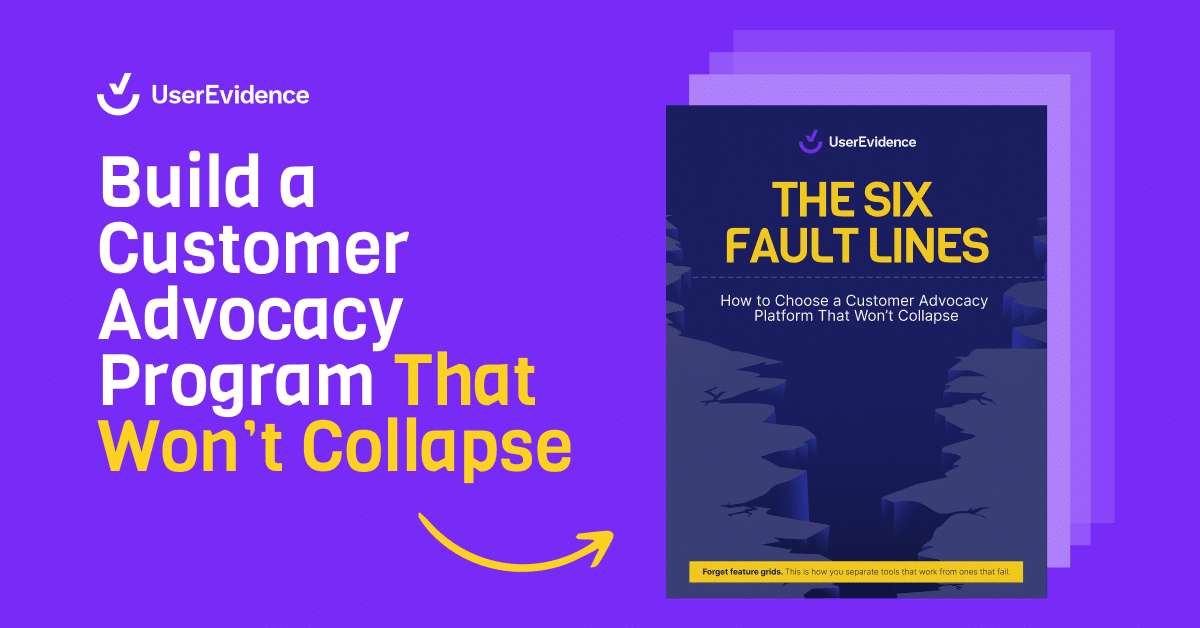Today, B2B buyers are sourcing purchase information about new products and solutions on their own. According to Gartner, 33% of B2B buyers want a seller-free sales experience (44% for millennials). This means that sales reps only get a short amount of time with potential buyers — 17% to be exact. With less face time, it’s up to customer marketing teams to communicate value through digital channels and establish brand credibility as early on in the buyer’s journey as possible. To do so, customer marketing managers must gather ample customer stories and social proof points that prove the success and happiness of current and past customers.
A key goal of every customer evidence program is acquiring and building a robust library of social proof, customer success stories, and user ROI data in the form of consumable marketing and sales content. It’s essential to provide sales teams with customer proof points to share with their buyers at key points in the buyer’s journey. However, building a library of customer proof is easier said than done, and the process is often bogged down by time-consuming and tedious tasks and hours of back-and-forth with customers. To add to the headache, it’s often difficult to get approvals from a company’s legal or PR team to allow their brand’s success story to be publicized.
Fortunately, we know a thing or two about how to easily capture and leverage customer evidence. Let’s dive into the four strategies below.
1. Collect feedback automatically at important moments throughout the entire customer lifecycle
Customer marketing managers and their teams often struggle to garner customer evidence and create impactful user stories due to time constraints. For example, to create a case study, customer marketing managers need to coordinate with the customer and find a time to chat about their experience. With busy schedules and meetings piling up for both parties, finding a time to meet is a challenge. Not to mention, it takes a lot of time and energy to interview stakeholders, get approval from legal teams, refine the content based on feedback, and then have a designer create attractive content. Typically, this process can take weeks or even months to finalize (we’ve even heard years for Fortune 500 banks, and a few social media giants).
The solution? Scale your outreach to a one-to-many approach, and allow clients to share feedback asynchronously. With the right tool, customer marketing managers can send out a survey via an email or URL to hundreds (even thousands) of users and customers to capture feedback and data at scale. Once the results are in, customer marketing managers are equipped with insights from:
- Users/decision-makers of different seniorities
- Companies across multiple industries
- Users of different personas/functions
- Various company sizes (e.g. F500 vs SMB)
Armed with a treasure trove of data, customer marketing managers can leverage these insights and user feedback to develop impactful and persuasive marketing and sales collateral. With the most efficient customer marketing technology, customer marketing managers are empowered to automate points of collection via customer surveys (e.g. post-deployment), surveys for specific products (e.g. launches), use cases, industries, and more. Each of these surveys can be triggered at logical points in the customer journey, enabling customer marketing managers to continuously capture customer evidence in an always-on, set it and forget it manner.
2. Allow customers to share anonymous customer evidence
Major organizations such as those in financial services and the federal government don’t typically want to have their brand name publicized in a case study or other collateral. Because of this, these organizations often opt out of providing customer stories, leading to significant representation gaps in a customer marketing team’s library of customer success stories.
The key to acquiring customer evidence from high-profile corporate customers is to allow the company to share their story in a safe and anonymous way. In doing so, users at these large brands are more inclined to feel comfortable providing feedback, information, and details about their success with a vendor’s product.
Another key aspect is how you position the ask to the customer. If you ask directly for a case study, it is implied that the case study will name their brand, and it’s also implied that it will be a long and time-consuming process and a heavy lift for the customer. If you position the ask more as a short feedback survey, with the option to remain anonymous, you are much more likely to get participation.
Take a look at the example of how Yellowbrick used this low-friction approach to capture high-impact customer evidence from a large financial services customer who wouldn’t normally share their story publicly.
3. Create customer stories for different industries, personas, and use cases at scale
Another common challenge customer marketing managers face is creating relevant and targeted customer evidence specific to prospects in a certain industry, persona, company size, or geography. Not only is the process time-consuming (imagine you sell to 16 industries across 4 regions, with 3 personas and 3 company-size segments — that’s over 1,000 combinations of unique customers!), it also requires insane amounts of resources and energy to fill out a content library like that. Thus, it’s important to leverage the right customer marketing technology to collect data and feedback from a broad and diverse sample of users/customers in different:
- Industries
- Geographic locations
- Company sizes
- Buyer personas
- Competitors
- Use cases, and more
But collecting this data is one thing. Another is having the ability to segment the data and create compelling visualizations/presentations of the sliced/filtered feedback (e.g. here’s a selection of healthcare users). Templatization can allow a customer marketing manager to repurpose one large data set of customer evidence into dozens of targeted content offers. With advanced customer marketing technology, they are able to easily chop up this data into laser-targeted content for prospects. Check out these two examples from GitLab:
- A detailed case study explaining how GitLab reduced development time by 18% for a small tech startup
- A graph detailing how GitLab users in the Industrial Manufacturing Industry reduced development time with GitLab
Discover how Wrike leverages UserEvidence to privately review survey responses and publish hundreds of proof points across various industries, company sizes, and personas by visiting their Research Library.
4. Prove value of your company’s product with searchable customer story library
Too often, customer marketing managers have scant and poorly organized libraries of customer evidence. Sales teams can’t find what they need, and constantly Slack/IM customer marketing managers asking where to find relevant customer stories. In today’s modern era, customer marketing managers need to have a broad and easily searchable arsenal of data points. Customer proof points need to be organized and tagged (by industry, use-case, competitor, size, etc.) so that customer marketing managers can easily find the right piece of collateral to input into marketing campaigns, and sales reps can identify the most relevant content to share with buyers at the right time in the buyer’s journey.
Relevance is key to gaining credibility with buyers and convincing them that a company has had success with similar-looking customers (e.g. same industry, size, use-case, etc.). A collection of wide-ranging customer evidence enables customer marketing managers to create impactful content that:
- Addresses each pain point
- Resonates with people at every stage of their buyer’s journey
- Further enables sales teams with a large library of stories and proof points at their fingertips to gain trust and win deals
Check out Yellowbrick’s dynamic Research Library and explore the unique content they were able to build from collecting customer evidence with UserEvidence.
Final thoughts
In today’s peer-influenced world, acquiring and leveraging customer evidence in marketing and sales initiatives is no longer a nice-to-have. It’s a critical piece of the puzzle that will enable marketing and sales teams to:
- Cut through the noise and attract new prospects
- Credibly illustrate and prove value
- Put customer voice into the center of the sales pitch
- Speed up sales cycles and reduce uncertainty for buyers
- Win more deals over competitors
Discover how UserEvidence enables you to automatically collect, review, and share customer success stories — book your demo.



